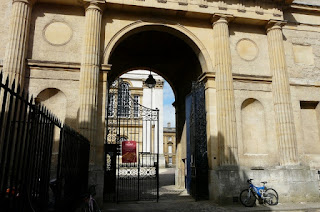"Literary Links" is a series of posts celebrating
Britain's wonderful links with great authors, dramatists and poets.
Quaintly snuggled
between the Tate Modern and the Globe Theatre is a surprising row of 18th
Century homes - surprising in that they have even survived on this busy
waterfront.
The ornate
plaque on number 49 declares that Christopher Wren (1632-1723) stayed here
while working on St Paul’s Cathedral opposite (between 1675-1710), but this is
a dubious claim. We do know that as the
head of the Office of Works he had a house in New Scotland Yard near Trafalgar
Square. We also know he went on to have
a home near Hampton Court, leased to him by Queen Anne, and a London home in St
James’s Street where he died. The
assertion that he lived here at number 49 is not supported, particularly since
this building was not built until 1710 – the same year St Paul’s was finished!
However,
there is a claim that the plaque once stood on a home east of here which was
demolished, and the ceramic plaque was saved and put here.
Despite debunking the claim for one famous resident number 49 can still lay claim to be the home for five years (1934-1939) of the English Actor and film director Robert Stevenson (1905-1986) and his wife the actress Anna Lee (1913-2004).
 |
| Robert Stevenson |
Robert’s name may not be as recognisable as
Wrens, but you will instantly know his work.
He directed over 50 movies including King Solmon’s Mines (1937), Mary Poppins
(1964), The Love Bug (1968), Bedknobs and Broomsticks (1971), and Herbie Rides
Again (1974).
| Anna Lee |
Anna Lee was
in over 60 films including How Green Was My Valley (1941), The Unsinkable Molly
Brown (1964), The Sound of Music (1965) and in the American soap opera General
Hospital.
This is an excerpt from the tour London River Walks - South Bank which
explores the southern bank of the River Thames.
The full tour is found on www.obelisktours.co.uk
















